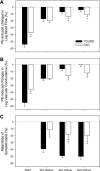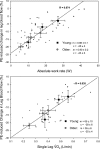Role of {alpha}1-adrenergic vasoconstriction in the regulation of skeletal muscle blood flow with advancing age
- PMID: 19060122
- PMCID: PMC2643895
- DOI: 10.1152/ajpheart.01016.2008
Role of {alpha}1-adrenergic vasoconstriction in the regulation of skeletal muscle blood flow with advancing age
Abstract
alpha(1)-Adrenergic vasoconstriction during dynamic leg exercise is diminished in younger individuals, although the extent of this exercise-induced "sympatholysis" in the elderly remains uncertain. Thus, in nine young (25 +/- 1 yr) and six older (72 +/- 2 yr) healthy volunteers, we evaluated changes in leg blood flow (ultrasound Doppler) during blood flow-adjusted intra-arterial infusion of phenylephrine (PE; a selective alpha(1)-adrenergic agonist) at rest and during knee-extensor leg exercise at 20, 40, and 60% of maximal work rate (WR(max)). To probe the potential contributors to exercise-induced changes in alpha(1)-adrenergic receptor sensitivity, exercising leg O(2) consumption (Vo(2)) and lactate efflux were also evaluated (n = 10). At rest, the PE-induced vasoconstriction (i.e., decrease in leg blood flow) was diminished in older (-37 +/- 3%) compared with young (-54 +/- 4%) subjects. During exercise, the magnitude of alpha(1)-adrenergic vasoconstriction in the active leg decreased in both groups. However, compared with young, older subjects maintained a greater vasoconstrictor response to PE at 40% WR(max) (-14 +/- 3%, older; -7 +/- 2%, young) and 60% WR(max) (-11 +/- 3%, older; -4 +/- 3%, young). It is possible that this observation may be attributed to lower absolute work rates in the older group, because, for a similar absolute work rate ( approximately 10 W) and leg Vo(2) ( approximately 0.36 l/min), vasoconstriction to PE was not different between groups (-14 +/- 3%; older; -17 +/- 5%, young). Together, these data challenge the concept of reduced sympatholysis in the elderly, suggesting instead that the inhibition of alpha(1)-adrenergic vasoconstriction in the exercising leg is associated with work performed and, therefore, more closely related to the rate of oxidative metabolism than to age per se.
Figures




Similar articles
-
Endothelin-1-mediated vasoconstriction at rest and during dynamic exercise in healthy humans.Am J Physiol Heart Circ Physiol. 2007 Oct;293(4):H2550-6. doi: 10.1152/ajpheart.00867.2007. Epub 2007 Aug 10. Am J Physiol Heart Circ Physiol. 2007. PMID: 17693542
-
Inhibition of alpha-adrenergic vasoconstriction in exercising human thigh muscles.J Physiol. 2004 Mar 1;555(Pt 2):545-63. doi: 10.1113/jphysiol.2003.054650. Epub 2003 Dec 23. J Physiol. 2004. PMID: 14694145 Free PMC article. Clinical Trial.
-
Ageing and leg postjunctional alpha-adrenergic vasoconstrictor responsiveness in healthy men.J Physiol. 2007 Jul 1;582(Pt 1):63-71. doi: 10.1113/jphysiol.2007.130591. Epub 2007 Apr 26. J Physiol. 2007. PMID: 17463044 Free PMC article.
-
Inefficient functional sympatholysis is an overlooked cause of malperfusion in contracting skeletal muscle.J Physiol. 2012 Dec 15;590(24):6269-75. doi: 10.1113/jphysiol.2012.241026. Epub 2012 Sep 17. J Physiol. 2012. PMID: 22988143 Free PMC article. Review.
-
Adrenergic and non-adrenergic control of active skeletal muscle blood flow: implications for blood pressure regulation during exercise.Auton Neurosci. 2015 Mar;188:24-31. doi: 10.1016/j.autneu.2014.10.010. Epub 2014 Oct 22. Auton Neurosci. 2015. PMID: 25467222 Review.
Cited by
-
Neural control of blood flow during exercise in human metabolic syndrome.Exp Physiol. 2014 Sep;99(9):1191-202. doi: 10.1113/expphysiol.2014.078048. Epub 2014 Mar 21. Exp Physiol. 2014. PMID: 24659613 Free PMC article.
-
α-Adrenergic regulation of skeletal muscle blood flow during exercise in patients with heart failure with preserved ejection fraction.J Physiol. 2024 Jul;602(14):3401-3422. doi: 10.1113/JP285526. Epub 2024 Jun 6. J Physiol. 2024. PMID: 38843407 Free PMC article.
-
Effect of age on high-fat diet-induced hypertension.Am J Physiol Heart Circ Physiol. 2011 Jul;301(1):H164-72. doi: 10.1152/ajpheart.01289.2010. Epub 2011 May 6. Am J Physiol Heart Circ Physiol. 2011. PMID: 21551274 Free PMC article.
-
Sympathetic nervous system activation reduces contraction-induced rapid vasodilation in the leg of humans independent of age.J Appl Physiol (1985). 2017 Jul 1;123(1):106-115. doi: 10.1152/japplphysiol.00005.2017. Epub 2017 Apr 6. J Appl Physiol (1985). 2017. PMID: 28385914 Free PMC article.
-
α-Adrenergic receptor regulation of skeletal muscle blood flow during exercise in heart failure patients with reduced ejection fraction.Am J Physiol Regul Integr Comp Physiol. 2019 May 1;316(5):R512-R524. doi: 10.1152/ajpregu.00345.2018. Epub 2019 Feb 21. Am J Physiol Regul Integr Comp Physiol. 2019. PMID: 30789790 Free PMC article.
References
-
- Bailey DM, Young IS, McEneny J, Lawrenson L, Kim J, Barden J, Richardson RS. Regulation of free radical outflow from an isolated muscle bed in exercising humans. Am J Physiol Heart Circ Physiol 287: H1689–H1699, 2004. - PubMed
-
- Barden J, Lawrenson L, Poole JG, Kim J, Wray DW, Bailey DM, Richardson RS. Limitations to vasodilatory capacity and V̇o2max in trained human skeletal muscle. Am J Physiol Heart Circ Physiol 292: H2491–H2497, 2007. - PubMed
-
- Dinenno FA, Jones PP, Seals DR, Tanaka H. Limb blood flow and vascular conductance are reduced with age in healthy humans: relation to elevations in sympathetic nerve activity and declines in oxygen demand. Circulation 100: 164–170, 1999. - PubMed
Publication types
MeSH terms
Substances
Grants and funding
LinkOut - more resources
Full Text Sources
Medical

